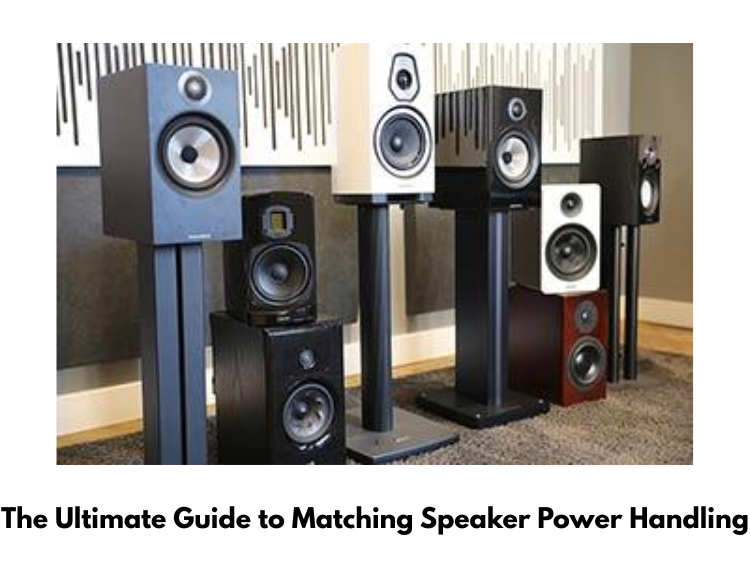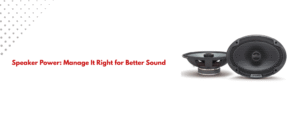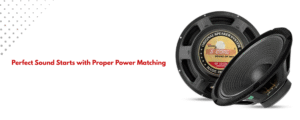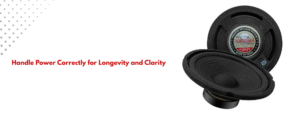When you’re making or replacing an audio system, it’s important to pick the right speakers and make sure they work with the power output of your amplifier. The power output of your amplifier and the power handling of your speakers may not match up. This could cause sound distortion, equipment damage, or even a fried speaker. We’ll show you how to match the power handling of your speakers to get the best sound quality and keep your setup from breaking.
How is Speaker Power Handled?
The power a speaker can safely take without breaking is called its “power handling.” Usually, this is given in watts, and there are two key numbers to look at: RMS power handling and peak power handling.
RMS Power Handling:
This is the amount of constant power that a speaker can take for a long time without breaking. This is the most important number to look at because it shows how well the speaker can handle loud sounds over time.
What is Peak Power Handling?
This is the most power that a speaker can handle for short periods of time, like sudden loud sounds or song changes. Peak power handling is important, but not as important when matching speakers to an amplifier for everyday use.
For more insights on selecting the best speakers for your audio setup, check out our guide on Top 5 Car Replacement Speakers for Superior Sound Quality 2025.
Why It’s Important to Match Power Handling
Making sure that the power handling of your speakers meets the power output of your amplifier will help you avoid a number of problems:
- Distortion: This can happen if your amplifier sends too much power to the speakers. This happens when there is too much sound coming out of the speaker.
- Damage to the Speaker: A speaker can be damaged if it is regularly exposed to higher power levels than it can handle. This could cause the drivers to blow or the speaker not to work.
- Overloaded Amplifier: If the speaker’s resistance is too low for the amplifier, on the other hand, it can fail or break down because it gets too hot.
How to Handle Power Rights
With that out of the way, let’s talk about how to match the power handling of your speakers to the output of your amplifier.
Step 1: Understand the Output of Your Amplifier
For starters, look at the amplifier’s specs. More often than not, the power output is given in watts per channel. It’s important to know both the RMS and peak values. A lot of home audio amplifiers have a power rating of 30 to 100 watts per channel. Depending on the setup, car amplifiers can have a rating of 50 to 1000 watts per channel.
Step 2: Check the Power Handling of Your Speaker
RMS power handling and peak power handling are the two scores that most speakers have. The RMS number tells you how much constant power the speaker can handle for a long time without breaking. Say, a speaker that has an RMS value of 100 watts can handle 100 watts of power all the time.
Step 3: Make Sure the RMS Power Ratings Match
Most of the time, it’s important to make sure that the RMS power output of your amplifier matches the RMS power handling of your speakers. The RMS value of the speaker should be about the same as or a little higher than the RMS power of the amplifier. In this way, the speaker can handle the power without getting hurt.
As an example:
- You should look for speakers that can handle at least 100 watts RMS if your amplifier puts out 100 watts per channel at 8 ohms.
- If each channel on your amplifier puts out 150 watts, make sure the speakers you buy have a power level of about 150 watts RMS.
Step 4: Impedance
Another important thing to think about is speaker resistance. The resistance of most home speakers is either 8 or 4 ohms. The power the speaker needs from the amplifier depends on its resistance.
- Speakers with 8 Ohm impedance are more popular for home music and are compatible with most amps. Most of the time, they give the amplifier a more stable and easier load.
- 4 Ohm Speakers: These speakers need more power from the amplifier to work, so the sound may be louder. However, not all amplifiers can handle a 4-ohm load, so if you choose these speakers, make sure your amplifier can handle them.
Step 5: Watch Your Speaker Volume
You might want to get speakers with a higher power level so that they can handle the most power from your amplifier, but be careful not to drive them too hard. Even if the specs say the speakers can handle enough power, overdriving them can blow them. For the best results, always work within the amount that is given.
Conclusion
It is very important to match the power handling of your speakers to the output of your amplifier if you want clear, distortion-free sound and for the life of your equipment. When you’re making your choice, always put RMS power handling and resistance first, and don’t forget to look at your amplifier’s specs. With the right setting, you can listen to high-quality music for years without having to think about damage or bad sound.




